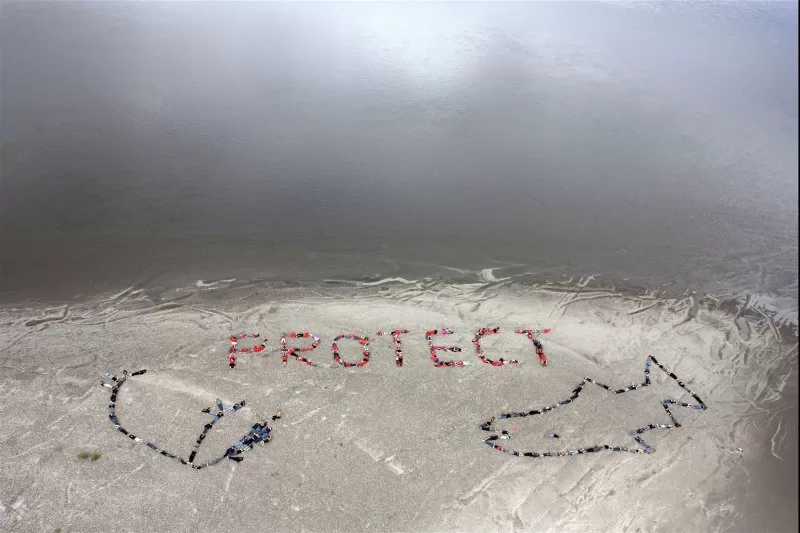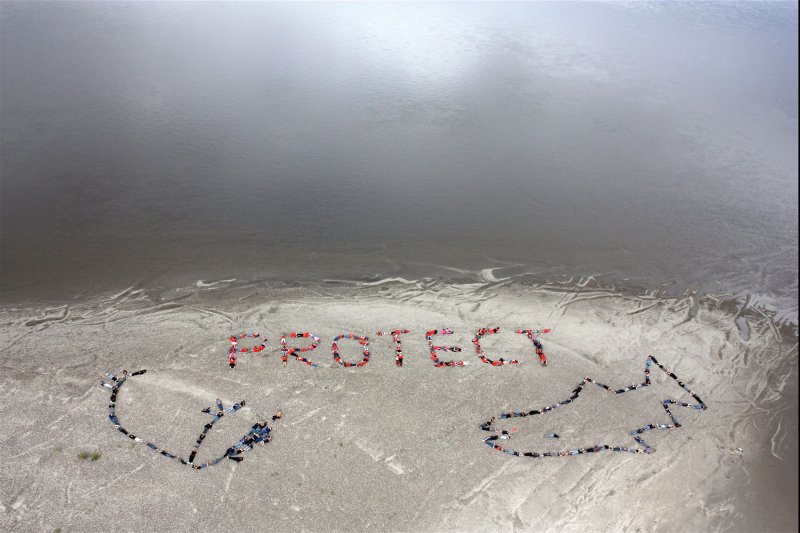Arctic native people of the Gwich’in Nation form a human banner on the banks of the Porcupine River near Fort Yukon, Alaska, with a message to protect the Arctic National Wildlife Refuge from oil development in 2010. On Thursday, NOAA announced a $105 million investment to restore salmon in Alaska waters that Indigenous communities subsist on. File Photo by Camila Roy/UPI |
License PhotoAug. 1 (UPI) — The Biden administration is investing another $105 million to assist salmon recovery projects in the Pacific Northwest and Alaska, the National Oceanic and Atmospheric Administration announced Thursday.
This effort is the next step in a series of measures to restore salmon and their habitat in West Coast waters. It’s part of the Pacific Coast Salmon Recovery Fund, which allocates money to the species and charts a future path of habitat sustainability.
The investment will be channeled to projects in Alaska, California, Idaho, Oregon and Washington “that include habitat restoration, stock enhancement, sustainable fisheries and research and monitoring,” NOAA said. It will be coupled with money being invested by Indigenous communities to assist salmon populations, which has been ongoing.
“This $105 million investment… will build on decades of salmon recovery work, while helping Pacific coast tribes and Alaska Natives sustain their communities and cultural traditions in the face of climate change,” said U.S. Secretary of Commerce Gina Raimondo. “This is a result of the most ambitious climate agenda in history, and I am proud that nearly half of all funds in this announcement are being awarded to Tribal applicants.”
Salmon restoration has been front and center in recent years, as persistent Western drought has reduced water levels in key habitat areas and threatened salmon and other aquatic life. NOAA took the rare step of canceling the Chinook salmon and Sacramento River fall-run Chinook, which returned to California’s Central Valley last year at “near-record low numbers.”
Earlier last year, the Environmental Protection Agency took steps to protect Alaska’s Bristol Bay watershed under the Clean Water Act to prevent the deposit of pebbles that could disrupt salmon resources.
That action prohibited the disposal of dredged material or other waste in key watersheds.
Thursday’s funding move will help in the recovery efforts of 28 salmon and steelhead species listed as Endangered, other salmon that are not protected, as well as steelhead that are necessary for native subsistence or tribal treaty fishing rights, and for those in the Columbia River Basin, according to NOAA.
“The PCSRF program has benefited fish populations and their habitats in so many ways,” said Janet Coit, assistant administrator for NOAA Fisheries. “The value of these investments goes far beyond recovering Pacific salmon and steelhead and their habitats, to also provide community and economic benefits, such as jobs and climate resilience.”

